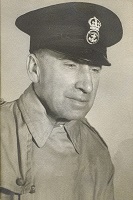|
Service information for:
He never talked much about the war. What I do know is that he joined sea cadets at Royal Roads, near Victoria in 1935 or 36 and immediately went RCN when he turned 18. Mom said he was below decks down near the keel working on the "sword" or the "transducer" (whatever that means) of the ASDIC antenna pod when the torpedo struck. Apparently safety protocols required that all water tight hatches had to be sealed until the ship was safely anchored and inspected. He was trapped below decks for an extended period. Mom said he had nightmares for a very long time afterward. After recovery leave, he was sent for officer training which he completed just as the war ended. He elected to retire as a CPO because the benefits were better - or so he was told. He was never sure about that.
After the war, he and his father RN CPO A.T. Bailey (HMS Rajputana) took their veteran's and survivor benefits and homesteaded at Cobble Hill, BC. Dad was recalled by the RCN in 1952 to act as a civilian contractor manning a covert fishing boat equipped with the latest sonar. It was a joint RCN, USN, USAF operation based out of a decommissioned RCN dock on Princess Royal Island. The patrol took them from the Alaska Canadian Boarder to Prince Rupert to Annette Island to Kitimat and back looking for Russian submarines. Story 1 was that Prince Rupert was the main railhead for all military supplies going to Alaska. Story 2 is as follows (I am assuming the following is no longer part of the Official Secrets Act as it is on the internet). In 1950, a USAF B36 out of Alaska for Washington dropped a nuclear bomb somewhere around Princess Royal Island after losing 4 of its 6 engines. The crew bailed out and all but 3 were picked up by RCN ships around Princess Royal Island. The unmanned aircraft continued to fly a circular pattern on autopilot crashing north of Terrace BC (around Bell 2). It was discovered and salvaged by the USAF during the winter of 1954/5. Dad told me the story in 1973 as a warning when I got my first commercial flying job in the area. The internet says the bomb's TNT charge exploded at 5,000' Above Ground Level - without the nuclear arming devises. It also states the nuclear components were recovered during the 1954 aircraft salvage operation. Dad's contract ended shortly afterward. Story 3: During my time with Transport Canada Civil Aviation I visited Kitimat and talked to some of the old timers that built the Kamano Hydrogenerating station nearby. They remember the fishing boat and the Russian submarine threat but their story was that the government was afraid the Russians would try and torpedo the generators.
My mother had a close cousin, Harry Winny, who had been a RCAF Wing Commander flying PBY's based out of Prince Rupert, Coal Harbour and Tofino during the war. Long story short, dad ended up as a logistics technician in the spring of 1955 working for the RCAF in preparation for the Avro Arrow deployment. When he told me the covert operations story in 1973 he implied, half jokingly, that the military just wanted to keep an eye on him after his work as a spy. The Arrow project was cancelled in Feb 1959 and dad went on to civilian life. Married, divorced, 4 kids, content.
Ships served in: HMCS MAGOG - Served in MAGOG from commissioning (07 May 1944) until she was torpedoed (14 Oct 1944)
(1) Barney Bailey at Royal Roads 1938 (2) PO.HSD Bailey (3) On a minesweeper taking part in a harbour training exercise at Esquimalt 1941 - Barney Bailey left man crouched in front (left)
Sailors Service / Career Information Index
|





